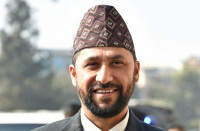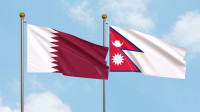National
400kV Inaruwa substation to ease power export
It will enable transmission of up to 4,000MW once the 400kV Inaruwa-Dhalkebar Transmission Line Project is ready.
Prithvi Man Shrestha
A transmission substation located at Inaruwa, Sunsari, the second largest power transmission facility in the country, was charged on Monday, enabling the country to transmit more power from the eastern region to the west as well as to India from Nepal.
The country’s second 400kV Gas Insulated System (GIS)-based substation was charged after its construction was completed. The project is a part of the Hetauda-Dhalkebar-Inaruwa 400kV Substation Expansion Project. It will enable transmission of up to 4,000MW of power once the construction of the 400kV Inaruwa-Dhalkebar Transmission Line Project is completed, according to Nepal Electricity Authority (NEA).
Construction of the Inaruwa-Dhalkebar transmission line is underway with the cables being installed, the NEA said.
“The construction work is expected to be completed by December this year,” said Dirghayu Kumar Shrestha, chief of the transmission directorate at the NEA.
According to utility officials, the substation would be an alternative to the Dhalkebar substation, which is the first 400kV GIS-based substation.
“The Inaruwa substation is the backbone for evacuating electricity generated from various projects in Koshi Province, transmitting power within the country and exporting excess power to India,” NEA Managing Director Kulman Ghising said, according to a statement by the electricity authority.
According to Ghising, the substation is also important for trading of electricity between Nepal and India through the proposed 400kV Inaruwa-Purnia Cross Border Transmission Line, and the proposed 400kV Inaruwa-Anarmani Transmission Line within Nepal. The second line has been designed to enable trading of power with both India and Bangladesh.
Construction of the Inaruwa substation, along with the completion of the under-construction Hetauda-Dhalkebar-Inaruwa line, are essential even for trading more power through the Dhalkebar-Muzaffarpur cross-border transmission line, according to officials.
The NEA expects to complete the Hetauda-Dhalkebar section of the project by July next year, according to Shrestha. The Hetauda-Dhalkebar-Inaruwa Transmission Line was initially funded by the World Bank. In 2021, the global lender pulled out of the project citing delays.
Nepal and India have agreed to increase the volume of power traded through the Dhalkebar-Muzaffarpur line once construction of the Hetauda-Dhalkebar-Inaruwa Transmission Line is completed.
During the 14th meeting of the Joint Technical Team (JTT) under the Joint Steering Committee held in New Delhi last month, two sides agreed to use the Dhalkebar-Muzaffarpur line to transmit power up to 1,000MW. The earlier capacity was 800 megawatts.
Ghising said that following the completion of the substation, electricity would also be distributed at the local level, besides evacuating power to the national transmission system.
“With the charging of a 400kV substation at Inaruwa, there will be improvement in voltage in the local distribution line and bring reliability in power supply,” he said, adding that it would also contribute to improving the supply of electricity to factories operating along the Morang-Sunsari Industrial Corridor.
In recent years, industrialists in the region have continued to complain about irregular power supply, particularly in the dry season or in winter when domestic plants produce around one third of their capacity and power should be imported from India.
A contract was awarded to Siemens Limited, India in December 2018 to construct two substations—one at Inaruwa and the other at Hetauda, according to the NEA. The combined cost of project implementation stood at Rs413.82 million, the NEA said. The Inaruwa substation cost as much as Rs204.8 million.
“Testing and commissioning work of the next 400kV substation at Hetauda is also ongoing,” the NEA said.




 13.12°C Kathmandu
13.12°C Kathmandu













%20(1).jpg&w=300&height=200)

